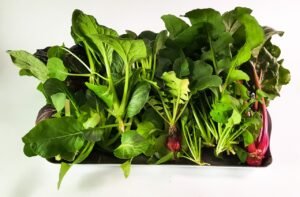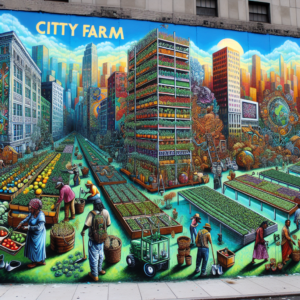
Imagine transforming a concrete jungle into a lush green oasis, where crops are grown amidst the bustling cityscape. With urban farming gaining momentum, it’s time to discover the potential of sustainable agriculture in the heart of our cities. In this article, we delve into the world of urban farming, where innovative techniques bring nature to our doorstep and nurture a sense of community, all while reaping the benefits of fresh, local produce. Step into the urban farm revolution, and witness how the concept of liquid lawn is revolutionizing our urban landscapes.

The Benefits of Urban Farming
Urban farming, also known as urban agriculture, refers to the practice of growing and cultivating food within cities or urban areas. This innovative approach to agriculture offers numerous benefits and has gained popularity in recent years. By integrating farming into urban environments, individuals and communities can enjoy a range of advantages that positively impact both the environment and the well-being of its residents.
Reduced environmental impact
One of the primary benefits of urban farming is the reduced environmental impact it brings. Traditional agriculture practices often involve long transportation distances for food to reach urban areas, resulting in high greenhouse gas emissions. In contrast, urban farming significantly reduces the distance food needs to travel, thus minimizing carbon emissions associated with transportation.
Moreover, urban farming can help mitigate the urban heat island effect, which refers to the higher temperatures experienced in cities compared to rural areas. Vegetation and green spaces created by urban farms can absorb heat, provide shade, and improve air quality, thereby lowering both energy consumption and pollution levels.
Increased access to fresh produce
Another significant advantage of urban farming is the increased accessibility of fresh produce to urban dwellers. Many cities lack sufficient access to fresh, nutritious food, especially in low-income areas commonly known as food deserts. Urban farming can address this issue by bringing food production closer to consumers.
By cultivating fruits, vegetables, and herbs within city limits, urban farms offer a local and affordable source of fresh produce. This accessibility helps improve dietary choices and contributes to the overall well-being of individuals living in urban areas. It also empowers communities to take control of their food systems, reducing reliance on long-distance food supply chains.
Community engagement and empowerment
Urban farming serves as a catalyst for community engagement and empowerment. These agricultural spaces create a sense of belonging and connection among residents, fostering a shared responsibility for sustainable living. By participating in urban farming initiatives, individuals are empowered to actively contribute to their community’s well-being and environmental sustainability.
Urban farms often host community events, workshops, and educational programs that promote a sense of ownership and encourage participation. These initiatives not only educate individuals about sustainable farming practices but also provide opportunities to connect with fellow community members. Through these activities, urban farming fosters a sense of pride in residents and helps build stronger, more cohesive communities.
Challenges and Solutions in Urban Farming
Despite the many benefits of urban farming, it is not without its challenges. Several factors can present obstacles to successful urban farm implementation, including limited space and infrastructure, potential sources of contamination, and cost and financial viability. However, innovative solutions and strategies have been developed to overcome these obstacles and ensure the sustainability of urban farming projects.
Limited space and infrastructure
One of the primary challenges in urban farming is the limited availability of space and suitable infrastructure within cities. However, innovative techniques such as vertical farming, rooftop gardens, and container gardening have emerged as viable solutions.
Vertical farming involves growing plants in vertically stacked layers, utilizing vertical space efficiently. This technique can be implemented in indoor environments, utilizing techniques such as hydroponics or aeroponics to provide plants with optimal growing conditions.
Rooftop gardens utilize underutilized space on rooftops to establish green spaces for cultivation. These gardens not only offer additional growing space but also provide insulation and reduce energy consumption, contributing to the overall sustainability of urban environments.
Container gardening allows individuals to cultivate plants in containers, such as pots or raised beds, making it suitable for individuals with limited outdoor space. Containers can be placed on balconies or even indoors, providing opportunities for urban farming in smaller living spaces.
Potential sources of contamination
Contamination concerns pose another challenge in urban farming, as urban areas often have complex and diverse sources of pollutants. However, numerous strategies can be employed to address these concerns and ensure the safety of urban farm produce.
Soil testing and remediation play a crucial role in identifying potential contaminants and developing effective remediation strategies. By regularly testing the soil for heavy metals, pesticides, and other harmful substances, urban farmers can take appropriate measures to mitigate contamination risks.
Hydroponic and aquaponic systems offer alternative cultivation methods that eliminate soil-related contamination risks. These systems use nutrient-rich water solutions or fish waste as the primary means of nourishing plants. They provide a controlled environment for plant growth and eliminate the need for soil altogether, thus reducing contamination risks significantly.
Furthermore, practicing organic and sustainable farming methods can minimize contamination risks. By avoiding the use of synthetic pesticides and fertilizers and instead relying on natural alternatives, urban farmers can ensure the purity and safety of their produce.
Cost and financial viability
The financial aspect of urban farming can be challenging, as it often requires initial investments in infrastructure, equipment, and ongoing operational expenses. However, implementing cost-effective practices and exploring diverse revenue streams can enhance the financial viability of urban farming initiatives.
Creating diverse revenue streams is key to ensuring the financial sustainability of urban farms. In addition to selling produce directly to consumers, urban farmers can explore other income-generating activities such as offering farm tours, hosting events, or selling value-added products like jams or sauces. These additional revenue streams help offset costs and contribute to the long-term viability of the urban farm.
Collaborating with local businesses can also provide financial support to urban farming initiatives. Establishing partnerships with restaurants, grocery stores, or farmer’s markets can ensure a consistent market for produce and create mutually beneficial relationships within the local community.
Implementing cost-effective practices, such as optimizing resource use and reducing waste, is crucial for the financial viability of urban farms. For example, utilizing rainwater harvesting systems, composting organic waste, and implementing energy-efficient technologies can minimize costs and maximize resource efficiency.

Creative Solutions for Limited Space
Urban farming faces the challenge of limited space within densely populated cities. However, creative solutions have been developed to maximize space utilization and make the most of the available areas.
Vertical farming
Vertical farming is a cutting-edge technique that enables farmers to grow crops in vertically stacked layers. This approach takes advantage of vertical space, allowing for increased crop yield within a smaller footprint. By utilizing technologies such as hydroponics or aeroponics, plants receive the necessary nutrients and light, leading to optimal growth and productivity.
Vertical farming is especially suitable for urban environments, as it allows farmers to cultivate crops indoors, thus reducing the reliance on land. By using vertical structures, such as shelves or towers, urban farmers can efficiently utilize limited space to produce a significant amount of fresh produce.
Rooftop gardens
Rooftop gardens provide an excellent solution for urban farming in areas with limited ground space. Utilizing underutilized rooftops allows for the creation of green spaces and agricultural areas that contribute to a city’s sustainability. Rooftop gardens offer an additional layer of insulation, reducing energy consumption and providing an aesthetic enhancement to buildings.
By utilizing appropriate techniques and materials, such as lightweight soil, structural support, and efficient irrigation systems, rooftop gardens can overcome the challenges of limited space and contribute to the urban farming movement. These gardens provide opportunities for growing a variety of crops, including vegetables, herbs, and even small fruit trees.
Container gardening
Container gardening is a versatile and accessible solution for urban farming, particularly for individuals with limited outdoor space. This method involves growing plants in containers such as pots, raised beds, or even repurposed objects like buckets or crates. Container gardening allows urban dwellers to cultivate plants on balconies, patios, or even indoors, making it suitable for apartment living.
Containers offer flexibility and mobility, enabling individuals to optimize their plants’ growth conditions by easily repositioning them to receive adequate sunlight or protection from adverse weather conditions. Container gardening also minimizes the risk of soil contamination and provides efficient space utilization by growing plants vertically or stacking containers.
Addressing Contamination Concerns
Contamination concerns in urban farming can arise from various sources, including polluted soils, air pollutants, or nearby industrial activities. However, several strategies can be employed to identify and address potential contamination risks, ensuring the safety of urban farm produce.
Soil testing and remediation
Soil testing is an essential step in addressing contamination concerns in urban farming. By regularly testing the soil for heavy metals, pesticides, and other harmful substances, urban farmers can assess potential risks and develop appropriate remediation strategies.
If contamination is detected, remediation techniques such as phytoremediation or soil amendment can be employed. Phytoremediation involves using plants that are known to absorb or degrade pollutants, therefore reducing their concentration in the soil. Soil amendment techniques, such as adding organic matter or specific minerals, can also help reduce contamination levels and improve soil quality.
Regular monitoring and testing of soil quality are crucial to maintaining a safe and healthy environment for urban farm produce and ensuring the well-being of consumers.
Hydroponic and aquaponic systems
Hydroponic and aquaponic systems offer alternative cultivation methods that eliminate soil-related contamination risks altogether.
In hydroponic systems, plants are grown in a nutrient-rich water solution, allowing them to absorb essential nutrients directly. This method is particularly suitable for urban farming, as it eliminates the need for soil and significantly reduces the risk of soil-based contamination.
Aquaponic systems combine hydroponics with aquaculture, creating a mutually beneficial relationship between fish and plants. The fish waste provides the necessary nutrients for plant growth, while the plants filter and purify the water for the fish. This closed-loop system ensures water quality while minimizing contamination risks associated with traditional agriculture practices.
By utilizing hydroponic and aquaponic systems, urban farmers can provide a controlled environment for plant growth and offer consumers safe and contamination-free produce.
Using organic and sustainable practices
Practicing organic and sustainable farming methods is an effective way to minimize contamination risks in urban farming. By avoiding the use of synthetic pesticides, herbicides, and fertilizers, urban farmers can ensure the purity and safety of their produce.
Organic farming relies on natural alternatives, such as biological pest control, crop rotation, and composting, to maintain soil fertility and control pests and diseases. Sustainable practices, such as water conservation, energy efficiency, and waste reduction, further contribute to the overall ecological balance of urban farming.
Certification programs, such as organic certification, can provide trust and assurance to consumers that urban farm produce meets stringent standards, ensuring their safety and quality.

Financial Viability of Urban Farms
Achieving financial viability is crucial for the sustainability of urban farms. By implementing cost-effective practices, exploring diverse revenue streams, and collaborating with local businesses, urban farmers can overcome financial challenges and ensure the long-term success of their farming initiatives.
Creating diverse revenue streams
Relying solely on the sale of produce may not be sufficient to achieve financial viability. To diversify income and reduce reliance on a single revenue source, urban farmers can explore additional income-generating activities.
Hosting farm tours, workshops, or educational programs can provide an opportunity to generate revenue while engaging with the community. Similarly, offering value-added products, such as jams, sauces, or baked goods made from farm produce, can appeal to a broader market and increase profitability.
Diverse revenue streams not only bolster the financial stability of urban farms but also contribute to community engagement and the overall success of the farming initiative.
Collaborating with local businesses
Collaborating with local businesses can provide essential support to urban farming initiatives. Establishing partnerships with restaurants, grocery stores, or farmer’s markets can ensure a consistent market for produce and create mutually beneficial relationships within the local community.
Restaurants and grocery stores value the availability of fresh, locally sourced produce, and are often willing to pay a premium for high-quality ingredients. By supplying these businesses, urban farmers can secure a steady income stream while strengthening ties with the local food industry.
Similarly, participating in farmer’s markets or partnering with community-supported agriculture (CSA) programs can provide direct access to consumers, eliminating the need for intermediaries and maximizing profitability.
Implementing cost-effective practices
Managing costs efficiently is a critical factor in achieving financial viability. Urban farmers can implement various cost-effective practices to optimize resource use and reduce unnecessary expenses.
Maximizing resource efficiency, such as water and energy, can lead to significant cost savings. Utilizing rainwater harvesting systems, drip irrigation, and energy-efficient technologies can minimize expenses and improve the overall financial performance of urban farms.
Furthermore, reducing waste and implementing recycling programs not only contribute to environmental sustainability but also save on waste disposal costs. Composting organic waste and utilizing compost as a natural fertilizer can close the nutrient loop and reduce the need for costly external inputs.
By adopting cost-effective practices, urban farmers can optimize financial resources, increase profitability, and ensure the long-term viability of their farming initiatives.
Promoting Access to Fresh Produce
Urban farming plays a vital role in promoting access to fresh and nutritious produce in areas that face challenges in obtaining such food. By implementing various strategies such as farmers’ markets, community-supported agriculture (CSA) programs, mobile produce markets, and urban food forests, urban farmers can ensure that fresh produce is readily available to all members of the community.
Farmers’ markets and community-supported agriculture (CSA)
Farmers’ markets are a cornerstone of the urban farming movement, providing a direct link between farmers and consumers. By establishing farmers’ markets within urban areas, urban farmers can offer fresh produce to local residents while fostering connections between producers and consumers.
Community-supported agriculture (CSA) programs are another successful model that connects farmers and consumers. Through CSA programs, individuals or families can purchase a share of the farm’s produce in advance and receive a weekly or monthly supply of fresh fruits, vegetables, and other farm products. This approach not only provides consumers with access to fresh produce but also supports farmers by providing a reliable market for their harvest.
Both farmers’ markets and CSA programs contribute to the local economy, encourage sustainable agriculture practices, and promote community engagement.
Mobile produce markets
Mobile produce markets are an innovative solution to bring fresh produce directly to neighborhoods or communities that have limited access to grocery stores or farmers’ markets. These markets operate from a mobile vehicle or truck and visit different locations on a scheduled basis, ensuring convenient access to fresh produce for residents who may face transportation barriers.
Mobile produce markets often prioritize underserved communities, allowing individuals to purchase fresh and healthy food without having to travel long distances. By bringing the market directly to the community, mobile produce markets help increase food security, improve dietary choices, and promote healthy living.
Urban food forests
Urban food forests are designed to mimic natural forests, but instead of native plants, they focus on growing edible plants and fruit-bearing trees. These forest-like ecosystems offer a diverse range of fruits, vegetables, herbs, and nuts, providing an abundant source of fresh produce to urban communities.
Urban food forests are typically established in public spaces such as parks or vacant lots, making them accessible to residents. These community spaces encourage residents to participate in the maintenance and harvesting of the forest, fostering a sense of ownership and empowerment.
By creating urban food forests, urban farmers can contribute to community food security, enhance biodiversity, and provide educational opportunities for individuals to learn about sustainable farming practices and reconnect with nature.
Educating and Engaging the Community
Education and community engagement are essential components of successful urban farming initiatives. By offering educational programs and workshops, providing volunteer opportunities, and implementing farm-to-school initiatives, urban farmers can educate and involve the community in sustainable agriculture practices.
Educational programs and workshops
Urban farms can act as learning centers, offering educational programs and workshops that teach individuals about sustainable farming practices, food cultivation, and the importance of local food systems. These programs can be tailored to different age groups and cover a range of topics, from basic gardening skills to advanced agricultural techniques.
Educational programs and workshops not only provide individuals with valuable knowledge but also foster a sense of connection to the food they consume and the environment they live in. By equipping individuals with the skills and knowledge to grow their own food, urban farming initiatives contribute to the development of self-sufficiency and resilience within communities.
Volunteer opportunities
Volunteer opportunities in urban farming can be a powerful way to engage the community, allowing individuals to actively contribute to the success of the farming initiative. By welcoming volunteers to participate in activities such as planting, harvesting, or maintaining the farm, urban farmers create a sense of ownership and shared responsibility among community members.
Volunteering on an urban farm provides individuals with hands-on experience in sustainable agriculture practices, promotes physical activity, and fosters social connections. It also allows individuals to witness the entire food production process, from planting seeds to harvesting, deepening their understanding of the importance of fresh, locally grown food.
Farm-to-school initiatives
Farm-to-school initiatives bridge the gap between urban farms and educational institutions, promoting healthy eating habits and supporting local agriculture. These initiatives focus on sourcing fresh produce from local farms for school cafeterias, providing students with nutritious meals and teaching them about the benefits of consuming locally grown food.
Through farm-to-school programs, students have the opportunity to engage with urban farms through farm visits, gardening activities, and nutrition education. These experiences not only expose students to the concepts of sustainable agriculture but also connect them to the source of their food, fostering a sense of appreciation and responsibility towards the environment.
By integrating urban farming into the education system, farm-to-school initiatives promote healthy lifestyles, support local farmers, and educate the next generation about the importance of sustainable food systems.
Policy and Government Support for Urban Farming
Policy and government support play a crucial role in the successful implementation and growth of urban farming initiatives. By enacting favorable zoning regulations and land use policies, providing financial incentives and grants, and collaborating with local governments, urban farmers can receive the support necessary to thrive in urban environments.
Zoning regulations and land use policies
Zoning regulations and land use policies that accommodate and encourage urban farming are essential for its long-term success. These policies should recognize urban farming as a legitimate land use category and offer incentives for its establishment.
Zoning regulations can designate specific areas within the city as suitable for farming or enable mixed-use zoning that allows for both agricultural and residential or commercial activities. Flexibility in land use policies can facilitate the conversion of vacant lots or underutilized spaces into productive urban farms.
Clear guidelines for urban farming, including permissible practices and structural requirements, provide clarity for farmers and reduce barriers to entry. Additionally, reducing bureaucratic hurdles and streamlining the permitting process can further encourage individuals and communities to embrace urban farming.
Financial incentives and grants
Financial incentives and grants provided by governments and organizations can significantly support the development of urban farming initiatives. Grants can help urban farmers cover initial set-up costs, such as acquiring land, building infrastructure, and purchasing equipment.
Financial incentives, such as tax breaks or reduced utility rates, can offer long-term financial support to urban farmers, helping them navigate financial challenges. These incentives can also encourage property owners to lease or sell land to urban farmers at affordable rates, making land more accessible for farming purposes.
Collaboration between governments and organizations can help identify funding opportunities, develop grant programs, and provide ongoing support and resources to urban farmers. By actively supporting and investing in urban farming, governments contribute to sustainable food systems, enhance community resilience, and promote environmental sustainability.
Collaboration with local governments
Collaboration with local governments is key to the success of urban farming initiatives. By engaging with relevant municipal departments, such as planning, economic development, and health, urban farmers can ensure their projects align with local priorities and regulations.
Collaboration can take various forms, including participation in local planning processes, advocating for the integration of urban farming in citywide initiatives, or contributing to the development of policies and regulations related to agriculture and food systems. By actively engaging with local governments, urban farmers can establish lasting partnerships and gain official recognition and support.
Furthermore, local governments can play a vital role in facilitating community engagement, organizing educational programs, or providing resources for urban farming initiatives. By working together, urban farmers and local governments can foster sustainable urban agriculture and contribute to the overall well-being of their communities.
Success Stories in Urban Farming
Urban farming has transformed communities around the world, providing inspiration and demonstrating the immense potential of sustainable agriculture in urban environments. Several success stories serve as examples of the positive impact urban farming can have on individuals, communities, and the environment.
Growing Power in Milwaukee, Wisconsin
Growing Power, based in Milwaukee, Wisconsin, is a renowned urban farming initiative that has made a significant impact on the community. Founded by Will Allen, a pioneer in urban agriculture, Growing Power operates an urban farm that utilizes innovative farming techniques to grow an impressive variety of fresh produce.
Growing Power also offers educational programs, job training, and community outreach. It has become a model for sustainable urban farming by effectively addressing issues of food security, community engagement, and empowerment.
The Rooftop Gardens Project in New York City
The Rooftop Gardens Project in New York City is an inspiring example of urban farming’s potential to transform barren rooftops into productive green spaces. Led by nonprofit organizations and community volunteers, this initiative focuses on converting rooftops into gardens that grow fresh produce for local communities.
The project not only produces food but also provides employment and educational opportunities for residents. By utilizing unused rooftop spaces, the Rooftop Gardens Project demonstrates the power of urban farming in promoting sustainable food systems and community cohesion.
Sweet Water Organics in Chicago, Illinois
Sweet Water Organics in Chicago, Illinois, is an innovative urban farming project that utilizes aquaponic systems to grow a variety of fish and fresh produce. Situated in a former abandoned warehouse, Sweet Water Organics demonstrates the transformative potential of urban farming in revitalizing forgotten urban spaces.
Beyond sustainable food production, Sweet Water Organics engages with the community through educational programs and outreach. By reimagining urban space and integrating aquaponics, this initiative has become a catalyst for urban revitalization and economic growth.
The Future of Urban Farming
As urban farming continues to gain momentum, the future holds immense potential for further innovations and advancements. Several key areas are expected to shape the future of urban farming, including innovations in technology, the integration of renewable energy, and the expansion of urban farming initiatives.
Innovations in technology
Technological advancements play a crucial role in the evolution of urban farming. From precision agriculture tools to smart irrigation systems, technology is constantly transforming farming practices and optimizing resource use.
Emerging technologies such as vertical farming, hydroponics, and aeroponics are likely to become more prevalent, allowing for increased crop production within limited urban spaces. Furthermore, the integration of automation and artificial intelligence in urban farming can enhance efficiency and reduce labor requirements.
Innovations in sensor technology, data analytics, and remote monitoring systems can improve resource management and optimize crop growth. By harnessing the power of technology, the future of urban farming is poised to be more productive, sustainable, and data-driven.
Integration of renewable energy
The integration of renewable energy sources in urban farming presents an opportunity to further enhance sustainability and reduce environmental impact. Solar panels, wind turbines, and other renewable energy technologies can provide clean and reliable energy to power urban farms.
Renewable energy systems can power lighting, heating, and cooling systems in vertical farms or rooftop gardens. By reducing reliance on the grid and fossil fuels, urban farms can minimize their carbon footprint and contribute to a more sustainable future.
The integration of renewable energy within urban farming can also create opportunities for off-grid farming in remote or underserved areas, ensuring equitable access to fresh produce.
Expansion of urban farming initiatives
The future of urban farming is expected to be characterized by the expansion of initiatives both in established cities and emerging urban areas. As more communities realize the benefits of urban farming, efforts to increase access to fresh produce and promote sustainable food systems will continue to grow.
Urban farming initiatives will likely become more integrated into urban planning processes, with an emphasis on maximizing space utilization, community engagement, and environmental sustainability. Governments and local policymakers will play an important role in providing support, establishing favorable policies, and allocating resources to facilitate the growth of urban farming initiatives.
The expansion of urban farming is not limited to large cities; smaller urban areas and suburbs are also embracing the concept. By tailoring urban farming practices to the unique needs and characteristics of different communities, urban farming has the potential to transform the food system on a global scale.
In conclusion, urban farming offers a range of benefits, including reduced environmental impact, increased access to fresh produce, and community engagement and empowerment. While challenges such as limited space, contamination concerns, and financial viability exist, creative solutions have emerged to overcome these obstacles. Strategies such as vertical farming, soil testing, and collaboration with local businesses contribute to the success of urban farming initiatives. By promoting access to fresh produce, educating and engaging the community, receiving policy and government support, and learning from success stories, urban farming has the potential to transform the way we think about food production and promote sustainable living in our cities. With advancements in technology, integration of renewable energy, and the ongoing expansion of urban farming initiatives, the future of urban farming holds promise for a more resilient, equitable, and sustainable food system.







